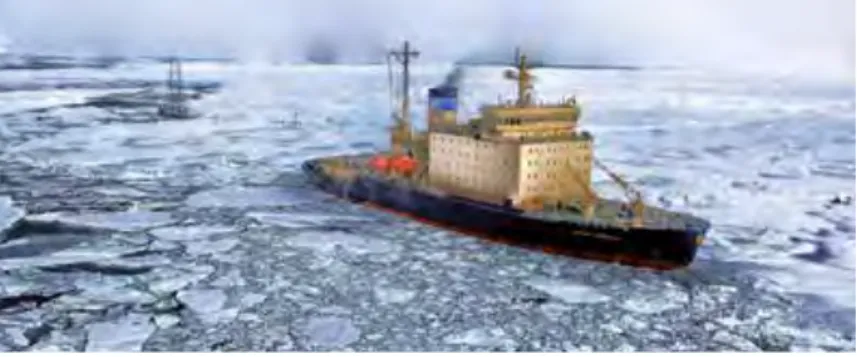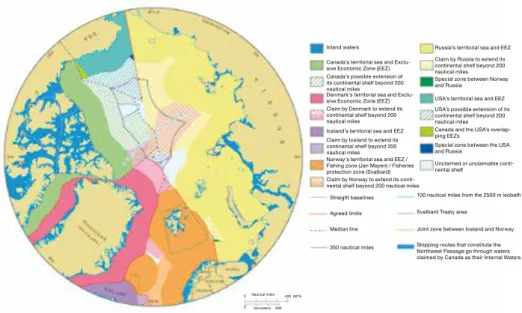260 | The governance of the ocean The Arctic is a place of transit and of settlement. Economic activity there is intense, marked by wide disparities in an environment renowned for being ‘difficult’ or even ‘hostile’. Shrinking of the ice cap due to climate change is opening up access to Arctic shipping routes, living (fish) and non-living resources (hydrocarbons, minerals), as well as places of tourist interest, thereby offering new opportunities for economic development (Fig. 1). Competition is becoming more acute for access to resources from the seabed up to the surface. All the conditions are in place for a ‘cold rush’ to arise, along with its adverse economic, social, environmental, and diplo-maticconsequences.
The Arctic faces two major gover-nance challenges. The first is reconciling the interests of very diverse stakeholders for harmonious economic development. The second is expanding institutional capacity fast enough to establish the
necessary environmental, social, legal, and diplomaticsafeguards.
Expansion of human activities in the Arctic is inevitable. Effective governance is complex since the Arctic has many definitions. The ‘race to the cold’ has already started, with strategies switching between building pressure and cooperation. Maritime bounda-ries still need to be formally agreed upon by all parties involved (Fig. 2). The Commission on the Limits of the Continental Shelf needs to rule on a few applications for extension of conti-nental shelves rich in hydrocarbons and minerals. There is no consensus on the legal status of the Northern Sea Route and Northwest Passage. Iceland has taken advantage of the lack of a regional fisheries management orga-nisation in the Arctic to unilaterally increase its mackerel quotas. Choices for development, coordination and cooperation will have a major impact over the Arctic in the comingyears.
Arctic fora
for cooperation
The Arctic is a place where coo-peration and dialogue are cultivated. The main intergovernmental forum is the Arctic Council. This forum was established in 1996 to promote cooperation, coordination and interaction among Arctic states. Its members – Canada, Denmark, the United States, Finland, Iceland, Norway, Sweden and Russia – can discuss common management issues, often related to sustainable development and environmental protection. Indigenous and local communities have specific repre-sentation within the Council, and their views are taken into account. Permanent observers – currently 12 non-Arctic states – take part in the discussions. In addition to fostering dialogue, the Arctic Council has promoted the production of scien-tific assessments in partnership with the International Arctic Science Committee(IASC).
At the instigation of the Arctic Council, the Arctic Economic Council, consisting of 36 business representatives, was established in 2014. Its objectives are to foster business development in the Arctic, deepen circumpolar cooperation and provide a business perspective to Arctic Councilprojects.
6. Governance challenges
in the Arctic
Mathilde Jacquot and Emmanuelle Quillérou
Fig. 1 –
Climate change is opening the way for the development of the Arctic,Governance challenges in the Arctic | 261
Legal framework
A few but important binding international agreements apply to the Arctic. The United Nations Convention on the Law of the Sea (UNCLOS) provides the main framework. UNCLOS allows for regulation of marine areas by provi-ding clear delimitation of maritime boundaries and a clear framework for access to resources, maritime navigation, protection of the marine environment, and scientific research. Other major international conven-tions apply in the Arctic, particularly for environmental protection and the fight against climate change. The ‘Polar Code’, the international code for ships operating in polar areas, adopted under the International Maritime Organization came into force on January 1st, 2017. It is a
bin-ding legal instrument for navigation in polar waters, with strong regional implications for the Arctic. Its nor-mative prescriptions supplement the International Convention for the Safety of Life at Sea (SOLAS), and International Convention for the Prevention of Pollution from Ships(MARPOL).
At the regional level, the Convention for the Protection of the Marine Environment of the North-East Atlantic (OSPAR) sets a framework for international cooperation to protect the marine environment which extends to a portion of the Arctic Ocean. Under the Arctic Council, two binding agreements have been signed between Arctic states: the first on the organisation of search and rescue after an accident (2011) and the second on the preparedness for and fight against marine pollu-tion by hydrocarbons in the Arctic (2013). As a way around the lack of a specific regional fisheries manage-ment organisation, the five Arctic states adopted in 2015 a declaration concerning the prevention of unre-gulated high seas fishing in the cen-tral ArcticOcean.
Scientific research
Several international organisa-tions carry out scientific research, monitoring, scientific initiatives and projects in the Arctic: Interna-tional Arctic Science Committee, Polar Council, French Arctic Initia-tive... Non-Arctic states are active providers of scientific expertise and research funding. These scien-tific collaborations can support the establishment of common and reco-gnised international scientific foun-dations, thereby helping to build trust and enhance cooperation in the Arctic. At a time when the European Union and other non-Arctic states are developing their own Arctic strategies, widening diplomatic and scientific cooperation beyond Arctic states could help foster more harmo-nious development of theregion.References
• H. AHLENIUS, K. JOHNSEN and C. NELLEMANN – Vital Arctic
Graphics. People and Global Heritage on Our Last Wildshores, UNEP/GRID-Arendal, www.grida.no/files/publications/vitalarcticgraphics.pdf, 2005.
• Conseil de l’Arctique – www.arctic-council.org.
• IBRU, Durham University – www.durham.ac.uk/ibru/resources/arctic. • International Maritime Organization – www.imo.org.
Fig. 2 –
Jurisdictional conflicts around the Arctic Ocean. © IBRU, Durham University, UK. nInland waters
Canada’s territorial sea and Exclu-sive Economic Zone (EEZ)
Claim by Russia to extend its continental shelf beyond 200 nautical miles Special zone between Norway and Russia USA’s territorial sea and EEZ
Canada and the USA’s overlap-ping EEZs
Special zone between the USA and Russia
Unclaimed or unclaimable conti-nental shelf
Straight baselines Agreed limits Median line
350 nautical miles
100 nautical miles from the 2500 m isobath
Svalbard Treaty area
Joint zone between Iceland and Norway Shipping routes that constitute the Northwest Passage go through waters claimed by Canada as their Internal Waters
Nautical miles kilometers 0 0 400 600 66°N
USA’s possible extension of its continental shelf beyond 200 nautical miles Canada’s possible extension of
its continental shelf beyond 200 nautical miles
Claim by Denmark to extend its continental shelf beyond 200 nautical miles
Claim by Iceland to extend its continental shelf beyond 200 nautical miles Norway’s territorial sea and EEZ / Fishing zone (Jan Mayen) / Fisheries protection zone (Svalbard) Claim by Norway to extend its conti-nental shelf beyond 200 nautical miles Denmark’s territorial sea and Exclu-sive Economic Zone (EEZ)
Russia’s territorial sea and EEZ

